You are viewing 1 of your 1 free articles
Pressing from the front
| Area | Three quarters of pitch |
| Equipment | Balls, bibs, cones, 2 full size goals |
| No. of Players | Up to 20 players + 2 goalkeepers |
| Session Time | Pressing boxes: 10mins Pressing game: 30mins Tactical press: 15mins |
This session is all about developing an appetite and a strategy to impose a high press on opponents in the attacking third.
Although there is a need for decision making and a structure to carry out an effective press, a lot depends on the desire and commitment of the first player and subsequent support behind.
This session begins by establishing the desire and the tempo in the warm-up pressing boxes activity. The subsequent pressing game then adds some context to the press, followed by a 9v9 game. The session ends with specific strategy that relates to the tactical formation of our team versus the opposition’s chosen shape.
Once we have established that it will be necessary to try a high press in order to disrupt the opposition’s capacity to build from the back, we run this type of session early in the week due to the physical demands of the high speed running and repeated sprints required.
“This session is all about developing an appetite and a strategy to impose a high press on opponents in the attacking third”
PRESSING BOXES
We set up two adjacent boxes of 16x16 yards each. We’re using 18 outfield players split into two teams of nine, who compete in possession and pressing battles in each of the boxes.
A coach starts play by serving a ball into the team of six in each box and the aim for the six possession players is to pass to keep hold of the ball. Three opposition players are sent in to full out press each of the passing teams for 45 seconds, making it 6v3 in each box, as shown [1]. Every regain of possession or touch on the ball from any of the three defenders scores one point, with the coaches keeping score.
The possession players should start off being restricted to two touches, but after players get used to the activity we then progress the game so the possession team is restricted to one-touch (apart from first player to receive from coach, who can have two touches if needed). We play for 10 minutes.
[1]
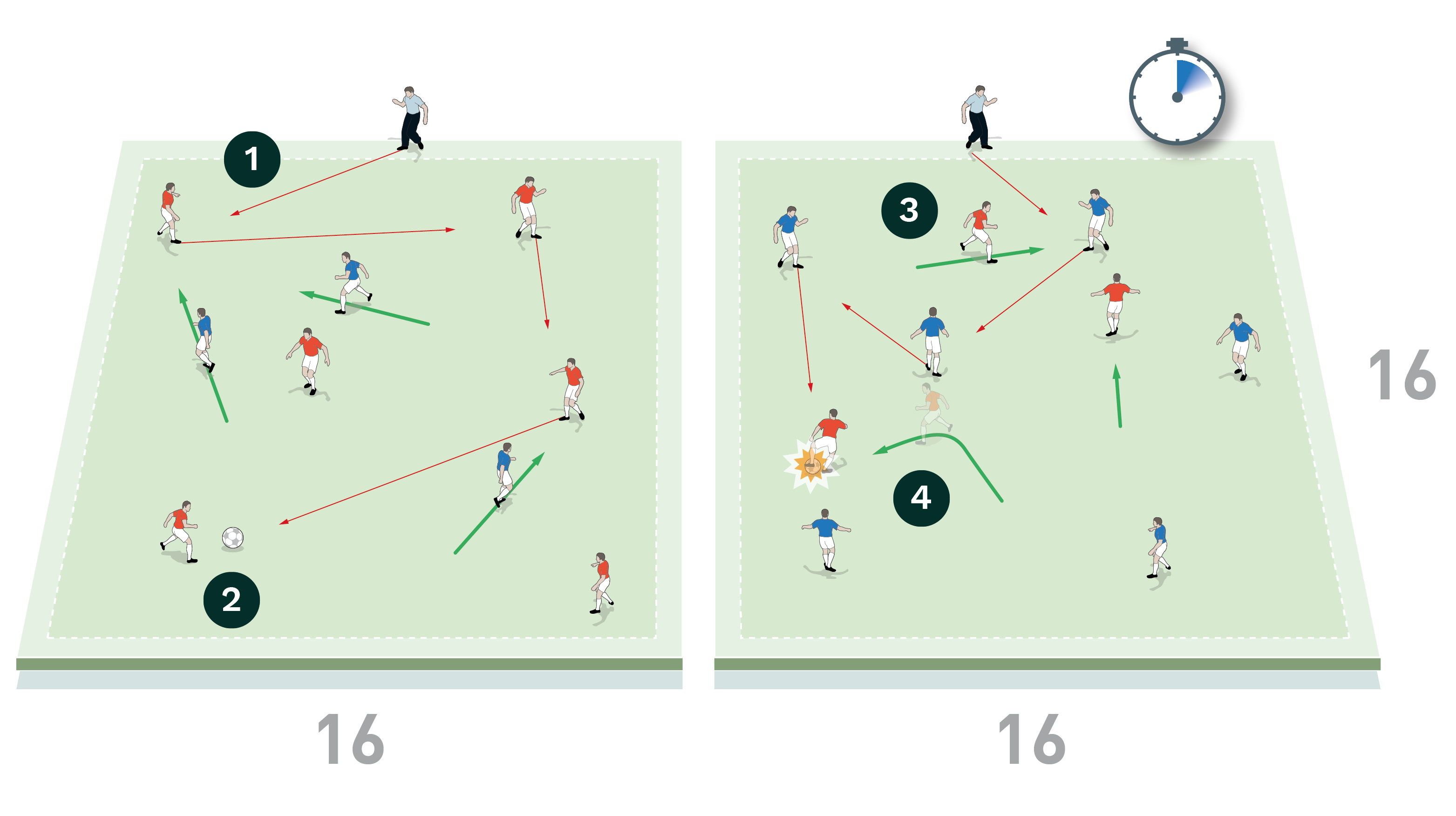
2. The aim for the six possession players is to pass to keep hold of the ball
3. Three opposition players are sent in to full out press each of the passing teams for 45 seconds, making it 6v3 in each box
4. Every regain of possession or touch on the ball from any of the three defenders scores one point
[2a]
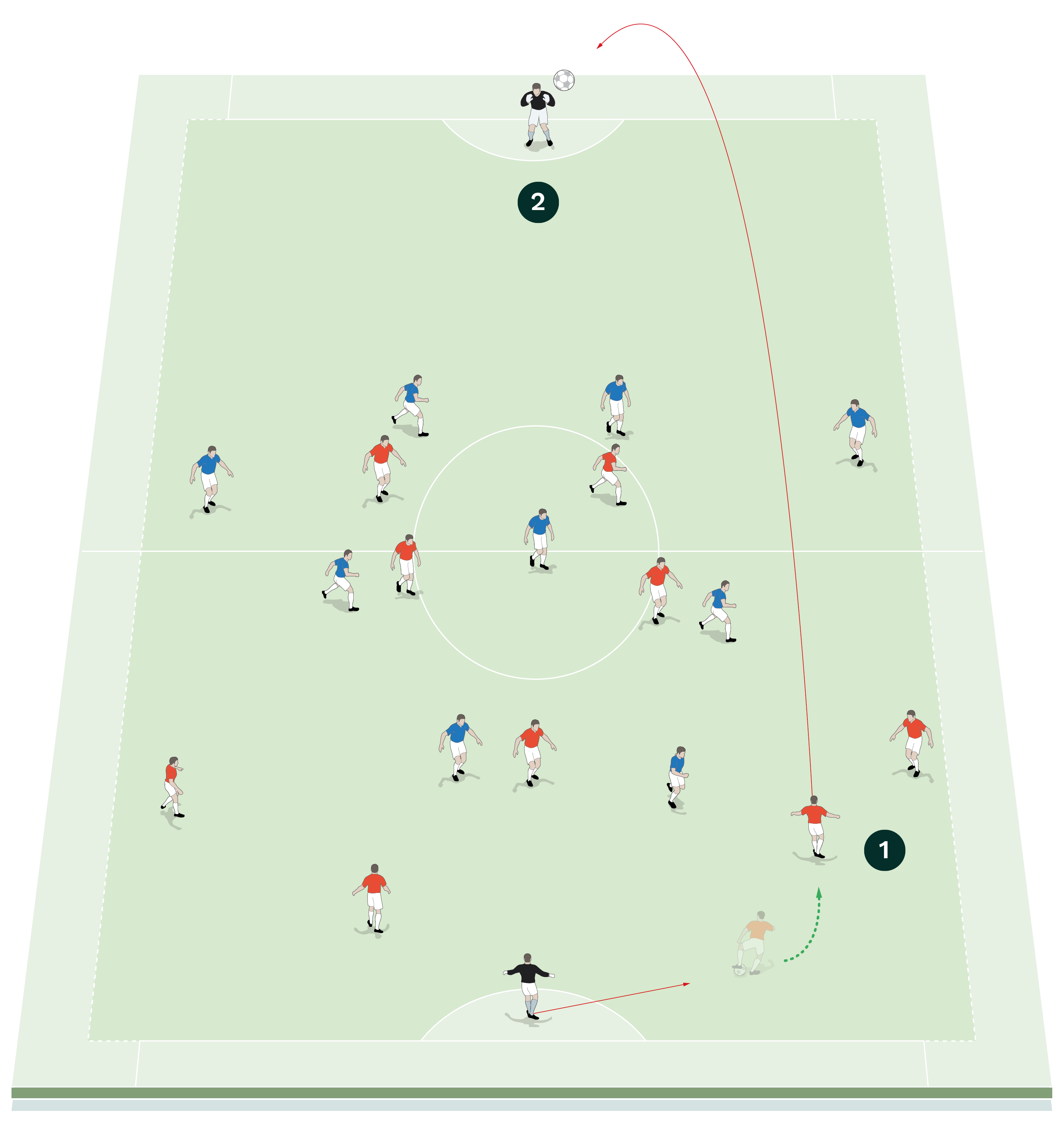
2. The aim for the possession team is to clip the ball into the hands of the opposition keeper to score a point
“The out-of-possession team must press the ball and their opponents to prevent the opposition from scoring”
[2b]
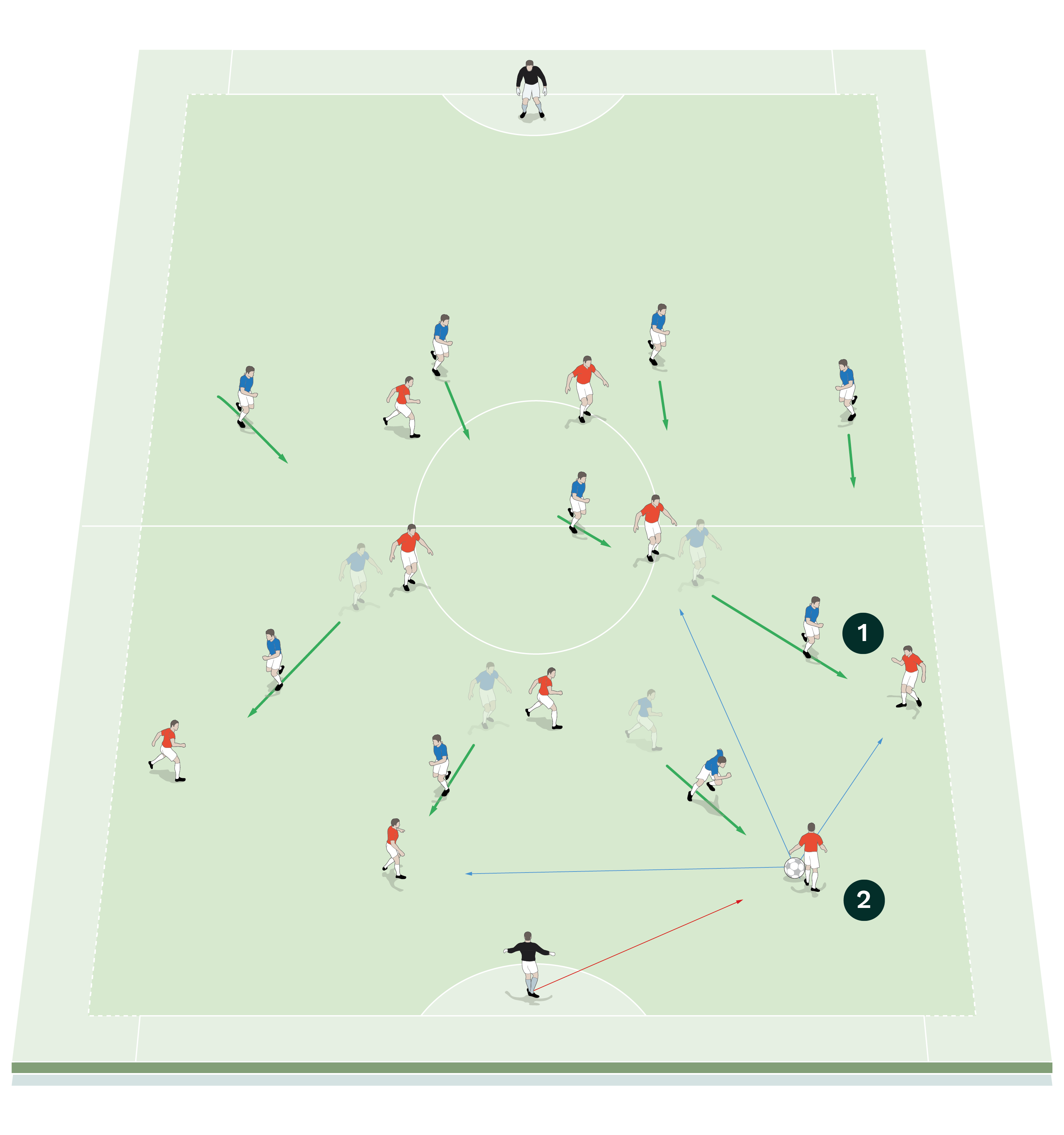
2. An uncoordinated press allows the possession player passing options to play around the high press
We set up on a pitch between the penalty boxes with the width coned off to 50 yards. A goalkeeper is positioned at each end. We’re using 18 outfield players split into two teams of nine, who play a high pressing game from the front and who are set up in a 4-3-2 formation.
Play starts with a pass from the goalkeeper to a defender. The aim for the possession team is to clip the ball into the hands of the opposition keeper, whose movement is restricted to within the ‘D’ of the penalty area, as shown [2a].
The out-of-possession team must press the ball and their opponents to prevent the opposition from scoring. For the first stage we ask the pressing team to apply a high press without regard for tactical cover or support in behind the initial press, as shown [2b], with the closest man to the ball going all out to press.
To stop the possession team scoring, for the second stage we now ask the pressing team to allocate a first defender to press. This player is the trigger for support pressing and his move is followed with a co-ordinated press by allocated player 2 and allocated player 3 and so on, as shown [2c]. This should show the players the benefits of a co-ordinated press.
To progress the session, we add a full size goal at each end of the area and we play a 9v9 game with the focus on high pressing from the front, as shown [2d]. We ask the players to implement what they have learnt from the activity so far.
We play each stage for 8-12 minutes.
[2c]

2. The first pressing player is the trigger for support pressing. A co-ordinated press by allocated player 2 and allocated player 3 follows. This restricts the passing options of the possession players
[2d]
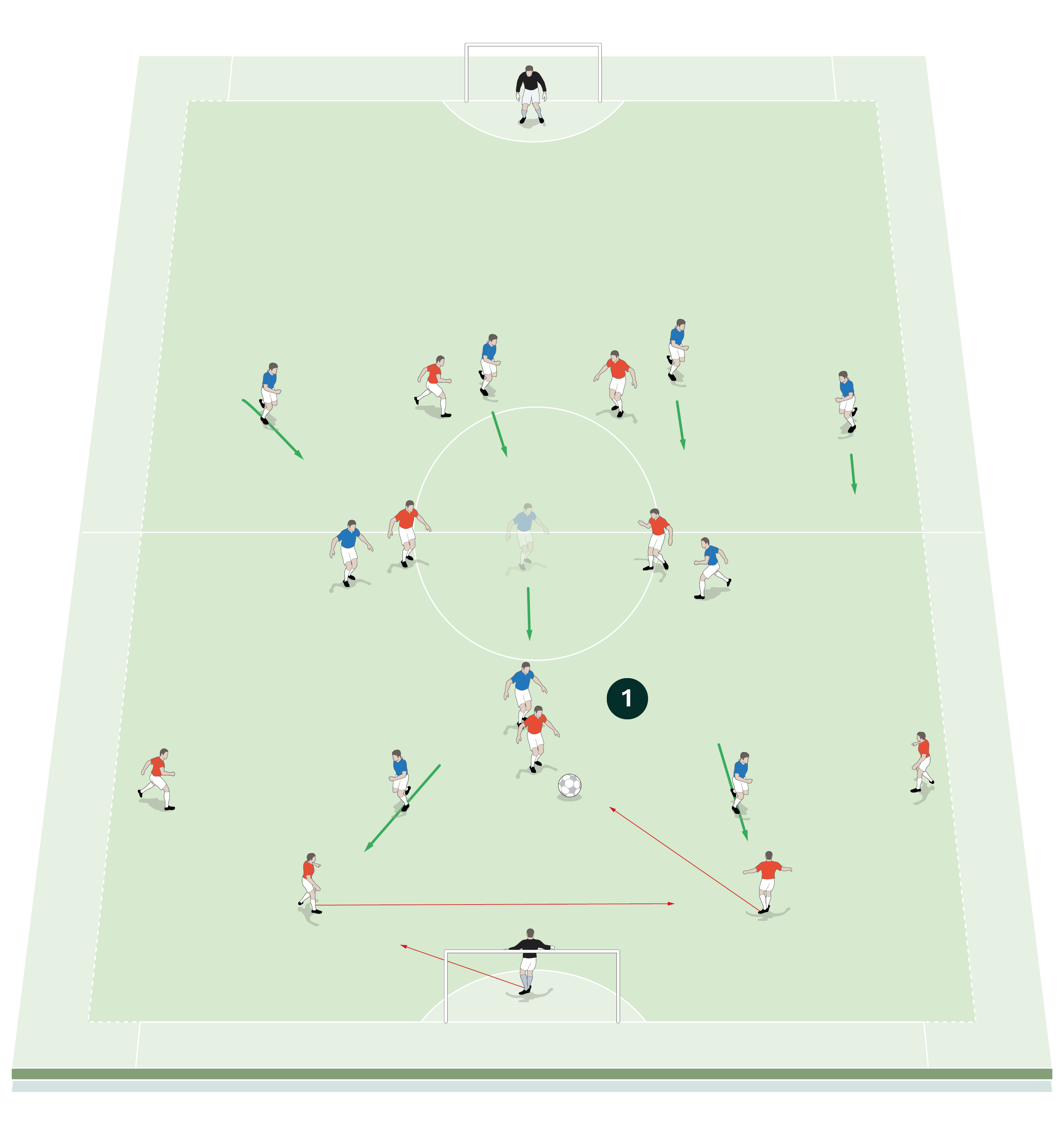
TACTICAL PRESS
We set up on three quarters of a pitch with a goal and goalkeeper at each end. We’re using the full width of the pitch. We’re using 20 outfield players and two goalkeepers split into two teams of 11.
Each team is shaped into appropriate formations with one team representing our normal line-up and the other team representing an opposition-specific formation. We ask the players to employ a tactical press from different areas of the pitch, as shown [3].
“If the high press works, on regaining the ball players need to be able to decide whether to immediately counter-attack or retain the ball”
[3]
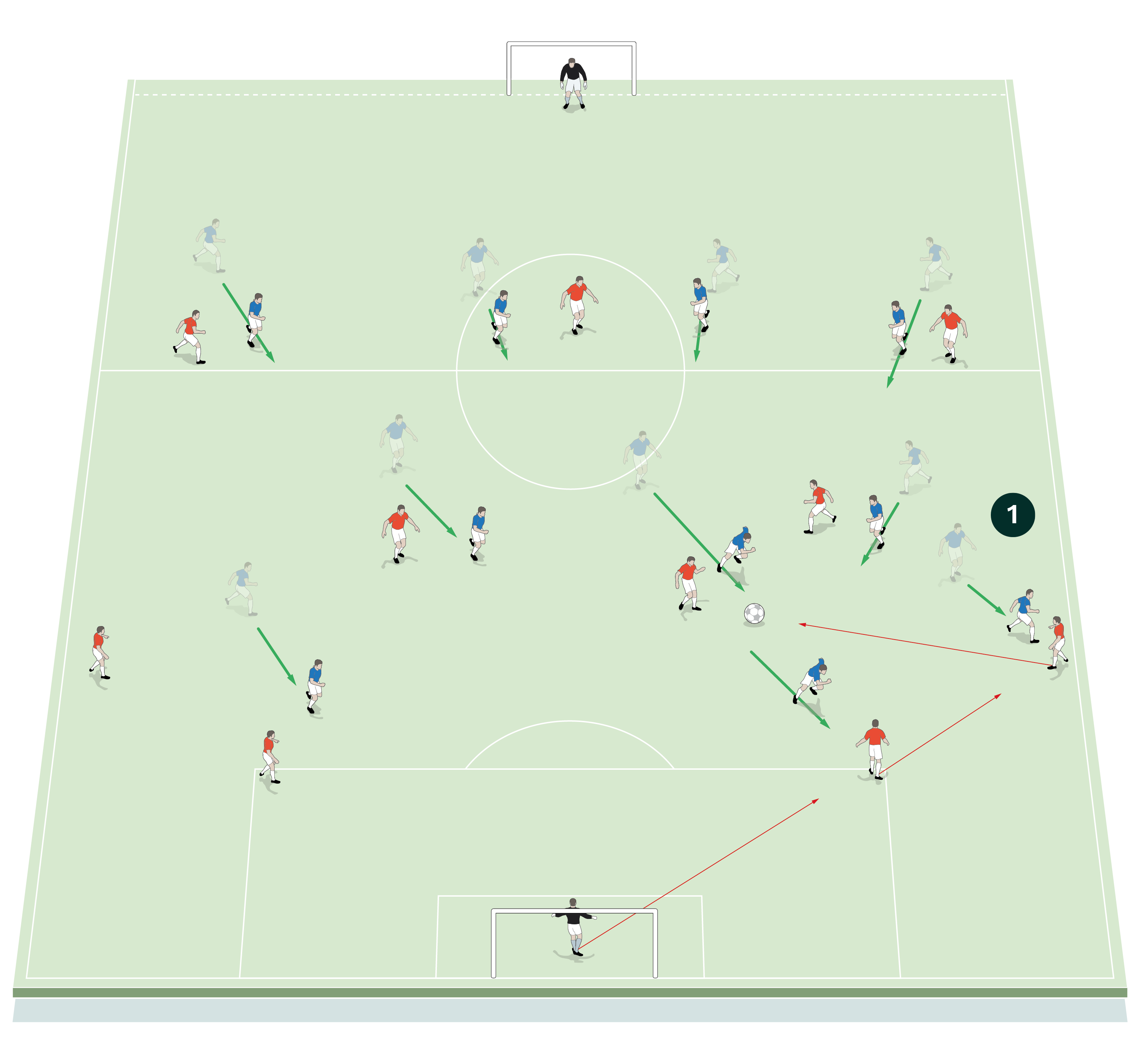
COACHING POINTS
What are the key things to look out for?
We want to see players demonstrating the desire and the capacity to press at good tempo. They should show a clear understanding of the triggers, the support angles needed and the timing of the supporting press. Players also need to understand when the initial press has been breached and subsequent recovery lines needed.
If the high press works, on regaining the ball players need to be able to decide whether to immediately counter-attack or retain the ball and build play gradually.
What are the typical mistakes players might make and how do I avoid them?
A common mistake that players can make is to press in isolation and get picked off by opponents. The poor timing of the supporting pressing player can make this worse and to prevent this happening players need to use the correct lines of approach to deny opponents a passing lane.
Related Files

David Moyes and Paul Nevin
Editor's Picks
Deep runs in the final third
Using the goalkeeper in build-up play
Pressing principles
Intensive boxes drill with goals
Penetrating the final third
Creating and finishing
My philosophy
Pressing initiation
Compact team movement
Coaches' Testimonials

Alan Pardew

Arsène Wenger

Brendan Rodgers

Carlos Carvalhal

José Mourinho

Jürgen Klopp

Pep Guardiola

Roy Hodgson

Sir Alex Ferguson

Steven Gerrard
Coaches' Testimonials

Gerald Kearney, Downtown Las Vegas Soccer Club

Paul Butler, Florida, USA

Rick Shields, Springboro, USA

Tony Green, Pierrefonds Titans, Quebec, Canada
Join the world's leading coaches and managers and discover for yourself one of the best kept secrets in coaching. No other training tool on the planet is written or read by the calibre of names you’ll find in Elite Soccer.
In a recent survey 92% of subscribers said Elite Soccer makes them more confident, 89% said it makes them a more effective coach and 91% said it makes them more inspired.
Get Monthly Inspiration
All the latest techniques and approaches
Since 2010 Elite Soccer has given subscribers exclusive insight into the training ground practices of the world’s best coaches. Published in partnership with the League Managers Association we have unparalleled access to the leading lights in the English leagues, as well as a host of international managers.
Elite Soccer exclusively features sessions written by the coaches themselves. There are no observed sessions and no sessions “in the style of”, just first-hand advice delivered direct to you from the coach.








